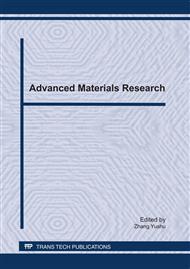[1]
R. Hartley and A. Zisserman: Multiple View Geometry in Computer Vision, Cambridge Univ. Press (2003).
Google Scholar
[2]
M. Fischler and R. Bolles: Random Sample Consensus: A Paradigm for Model Fitting with Applications to Image Analysis and Automated Cartography, Comm. ACM, vol. 24(1981), no. 6, p.381.
DOI: 10.1145/358669.358692
Google Scholar
[3]
P.H.S. Torr and A. Zisserman: MLESAC: A new robust estimator with application to estimating image geometry, Computer Vision and Image Understanding (2000), vol. 78, p.138.
DOI: 10.1006/cviu.1999.0832
Google Scholar
[4]
P.H.S. Torr: Bayesian model estimation and selection for epipolar geometry and generic manifold fitting, International Journal of Computer Vision, vol. 50(2002), p.35.
Google Scholar
[5]
R. Subbarao and P. Meer: Subspace estimation using projection-based M-estimator over grassmann manifolds, In Proceedings of the 9th European Conference on Computer Vision (ECCV2006), p.301.
DOI: 10.1007/11744023_24
Google Scholar
[6]
O. Chum, J. Matas and J. Kittler: Locally Optimized RANSAC, Proc. German Pattern Recognition Symp (2003), p.236.
DOI: 10.1007/978-3-540-45243-0_31
Google Scholar
[7]
B. Tordoff and D. Murray: Guided-mlesac: Faster image transform estimation by using matching priors, IEEE Transactions on Pattern Analysis and Machine Intelligence, vol. 27(2005), no. 10, p.1523.
DOI: 10.1109/tpami.2005.199
Google Scholar
[8]
O. Chum and J. Matas: Matching with PROSAC: Progressive Sample Consensus, Proc. IEEE Conf. Computer Vision and Pattern Recognition (2005), p.220.
DOI: 10.1109/cvpr.2005.221
Google Scholar
[9]
O. Chum and J. Matas: Randomized RANSAC with Td; d test, In Preceedings of the 13th British Machine Vision Conference (BMVC2002), p.448.
Google Scholar
[10]
J. Matas and O. Chum: Randomized RANSAC with sequential probability ratio test, In Proceedings of the 10th IEEE International Conference on Computer Vision (ICCV2005).
DOI: 10.1109/iccv.2005.198
Google Scholar
[11]
D. Capel: An effective bail-out test for RANSAC consensus scoring, In Proceedings of the British Machine Vision Conference (BMVC2005).
DOI: 10.5244/c.19.78
Google Scholar
[12]
D. Nister: Preemptive RANSAC for live structure and motion estimation, In Proceedings of the 9th IEEE International Conference on Computer Vision (ICCV2003), p.199.
DOI: 10.1109/iccv.2003.1238341
Google Scholar


